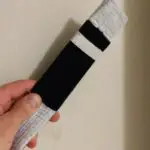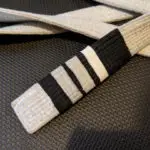Throughout your white belt journey, you may be wondering how many techniques you need to know. Should you be remembering everything that is taught? What will your instructor think if you can only do a handful of techniques? What are some techniques that you should learn in each position?
A white belt should know 2-4 techniques in escapes, submissions, passes, sweeps, and takedowns. Learning 2-4 techniques allows you to form a strategy and have backup techniques for when your first attempt fails.
- 2-4 escapes
- 2-4 attack/submissions
- 2-4 guard passes
- 2-4 sweeps
- 2-4 takedowns
In this article, I will go through each position and some techniques associated with them, along with fundamental ideas that occur within those positions.
What Are Good Resources To Learn BJJ Techniques?
Good resources to learn BJJ techniques when you’re on the go is the free Great Grappling App, BJJ Fanatics YouTube channel and website for the best instructional videos, and Flo Grappling for taking notes and analyzing BJJ matches and competitions.
Great Grappling App: This (free) app has a list of many techniques in every position and a description and video for each one. It relies on an internet connection as it utilizes YouTube for the videos.
BJJ Fanatics YouTube: An almost endless library of techniques taught by the world’s best instructors. John Danaher, Gordon Ryan, Bernardo Faria, Andre Galvao, and Marcelo Garcia the primary instructors that teach on this channel.
Flo Grappling: Flo Grappling’s YouTube channel provides a lot of competition videos that can give you a resource to watch top-level competitors compete. Take notes and pay attention to what top BJJ practitioners are doing in matches!
Does Your Instructor Expect You To Remember Every Technique They Teach?
Your instructor does not expect you to remember every technique they teach. They are teaching so many techniques because every person grasps techniques differently and have different body types that may utilize a certain technique better.
What works for one person, may not work for another.
Learning about each technique will give you an idea of what to expect your opponent can do even if you can’t do it yourself or understand it to the same level as someone else who uses it all the time.
Escapes
Learning escapes will be your top priority during your white belt. Side-control, mount, and back mount will be the fundamental positions to learn how to escape from. Techniques like knee-elbow, bridging, shrimping, grips, and arm traps are the primary skills to know to use during escapes.
Side-Control
Side-control escapes rely on creating space and then using frames and wedges to maintain that space. Space is used to get out of side-control either by regaining guard or moving out from underneath your opponent.
Sometimes creating space can be difficult. An opponent that stays tight to your body risks being rolled over because their weight distribution is comprising their balance.
Knowing multiple escapes techniques is essential to being effective at side-control escapes. Attempting one escapes will cause your opponent to react which may allow for another escape to be utilized more effectively.
Side-Control Escapes
- Escape to turtle
- Recompose guard
- Underarm spin
- Pummel to back
- Hand spear leg tackle
Mount
Mount escapes rely on off-balancing your opponent and taking advantage of the openings that create. Bridging can force your opponent to use their arms to balance themselves while moving their weight away from their legs. This opens opportunities to use your legs, arms, and hips to escape.
The mount in Jiu-Jitsu is an unpleasant position to be in BJJ and worst when you’re in a fight with punches. In BJJ, you can use patience to work for positions, while in a fight keeping your opponent close and your head tight will take power away from their punches.
Learning how to quickly and efficiently set up mount escapes will be key to success in both BJJ and MMA. Be sure to practice them often as this is a position you may not get to practice as much.
Mount Escapes
- Knee-to-elbow
- Bull rider
- Hip escape
- Pendulum
- Upa
- Grapevine escape
Back Mount
Once your opponent establishes a back mount is it is important to defend your neck by securing grips to prevent chokes. After grips are secured the legs must be passed to free your body from being further controlled. When the legs are passed and unable to re-hook the back mount is lost.
The back mount is known for having a strong side and a weak side. The strong side is when your opponent’s head is closer to the ground, the weak side is when your head is closer to the ground.
- Strong-side offers quick rear-naked chokes and easier transitions in and out of the back mount.
- Weak-side has most attacks available but could be easier for your opponent to escape.
When in back mount always be sure to watch your opponent’s feet, if they are crossed at any point take the opportunity to foot lock them. This is done by bringing your legs over their feet and hipping forward.
Back Mount Escapes
- Arm over back/Baseball bat
- Scoot down
- Elbows in
Attacks/Submissions
Attacks in Brazilian Jiu-Jitsu rely on controlling a position and/or seeing an opening your opponent has exposed. Position over submission is fundamental to setting up successful attacks.
Attacks can be set-up from both the top and bottom; however, being in the more dominant position opens up many more possibilities for attacks. During white-belt it is important, but not the set in stone rule, too:
- Learn to escape bottom positions
- Learn to control and maintain top positions
- Determine if you can transition to a more dominant position
- If you can’t transition and your position is controlled, look for a submission
These 4 steps will allow you to develop a strong positional game that will allow you to learn how to set up attacks quicker while maintaining position on your opponent.
Guard
The guard is an interesting position. When inside your opponent’s guard it is always advised to get out of it and not to attack. Any attacks from the top guard can lead you to get swept, mounted, or attacked.
Maintaining posture, controlling the hips and shoulders to move them out of alignment will give you the ability to successfully break and pass your opponent’s guard.
The bottom guard position opens up many more possibilities for attacks and sweeps than being inside someone’s guard. Off-balancing, changing angles, breaking posture, and controlling grips will give advantages and the ability to set up attacks and sweeps.
Guard Submissions
- Kimura
- Omoplata
- Armbar
- Triangle
- Cross-collar choke
Side-Control
Side-control attacks from the top range from the baseball bat choke to armlocks, while on the bottom escaping is the primary goal; however, submissions like the flytrap do exist from the bottom.
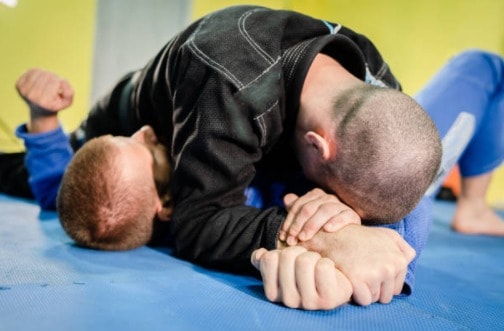
Maintaining side-control to set up a submission requires keeping your opponent flattened by keeping their shoulders on the ground. Once side-control is maintained a submission can be set up easier.
Side-Control Submissions
- Baseball bat choke
- Armlock
- Armbar
- Wristlock
- Americana
- Kimura
- Flytrap
Mount
Mount is one of the best positions for submissions, learning to maintain the position with pressure can even be enough to tap many new white-belts.
The most common submission that many new white-belts learn is the Ezekiel choke. It’s a quick choke that can be applied very easily in the Gi, and once both your arms are engaged in the choke it doesn’t matter if they roll you over and re-guard on you, the choke will continue.
Having an arsenal of submissions from the mount is what makes it such an attractive position to try to achieve. Many times armbars are available from the opponent pushing on you, or when the opponent tries pushing your hips their neck is open.
Mount Submissions
- Ezekiel choke
- Armbar
- Mounted Triangle
- Arm triangle
- Americana
- Kimura
- Cross-collar choke
- Bow-n-arrow choke
Back Mount
Back mount offers a safe attacking position as your opponent does not have many options other than escaping. Learning to control the back mount can open up many attacks from rear naked chokes (RNC) to armbars and reverse triangles.
Controlling your opponent with your hooks and a seatbelt grip will ensure your opponent cannot move freely, just be sure not to cross your feet as the person mounted can ankle lock you.
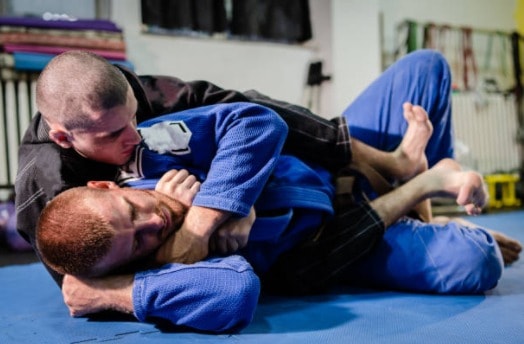
Once back mount is established it is a grip-battle for the neck. The opponent will be fighting your grips to prevent the choke and to get their shoulder to the ground, while you’ll be trying to beat their grip to slip your arms around their neck.
But, there is more than just chokes from the back mount. If your opponent is concentrating too much on the grip battle you can transition to an armbar or reverse triangle, or even trap their arm to open up their neck.
Back Mount Submissions
- Rear naked choke
- Armbar
- Reverse triangle
- Zipper choke
- Bow-n-arrow choke
- Neck crank
- Armlock
- Wristlock
Guard Passes
Learning to open and pass a guard is a fundamental ability you’ll need to learn and keeping working on throughout your Jiu-jitsu path. Being stuck in a guard in BJJ will cause many problems for you as your opponent will be trying to break your posture, off-balance you, or even submit you.
Learning to control and maintain dominant grips, fight grips, maintain posture, open their legs, and proceed to control them and their hips will be key to success in opening their guard.
Once the guard is open you need to learn to pass the legs and yes, you can learn to attack the legs, but at the white-belt level, it is much more fundamental to learn and know how to pass the legs.
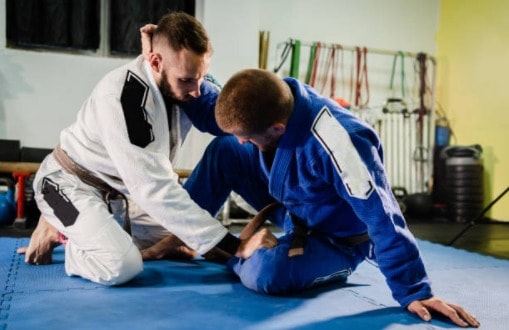
Guard Passes
- Split pass
- Pinning pass
- Pressure pass
- Knee cut
- Toreando pass
- Leg drag
Sweeps
A sweep in Brazilian Jiu-Jitsu is when you take your opponent from a dominant position and roll them over to gain the dominant position on them- you swept them. A sweep occurs from the bottom position guard, side-control, half-guard, mount, butterfly guard, and even lying on the floor with a standing opponent.
Sweeps are techniques that take advantage of your opponent transitioning, distributing their weight poorly, not basing properly, or exposing an opening that you can use to trap and control their limbs. Taking the opportunely will allow you to easily knock, roll, throw your opponent over.
Guard
The guard is the classic position to learn sweeps from, scissor sweeps to hip bumps. This is the position to learn the fundamentals of leverages, hooks, off-balancing, limb trapping, and weight distribution.
The guard allows you to off-balance your opponent, either to the left, right, forwards, or backward, each direction opening up a different sweep.
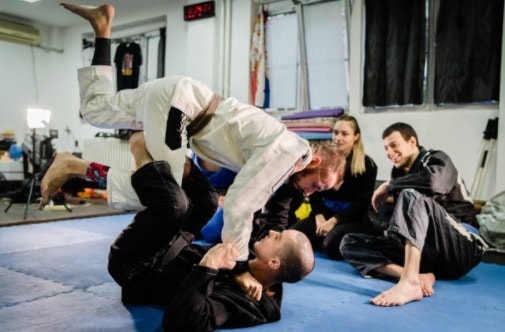
When your opponent’s weight is disturbed backward try a hip bump. Weight too far to the left? Try trapping their right side and scissor sweeping them. Maybe they are pushing into you use their weight to throw them overhead.
Guard Sweeps
- Hip bump
- Pendulum sweep
- Scissor sweep
- Balloon sweep
- Butterfly sweep
Side-Control
Side control sweeps are more dependent on your opponent’s weight distribution and using it against them to roll them over or sit up into them. Otherwise, your goal will be looking for frames and creating space to escape it.
Side-Control Sweeps
- Elbow roll
- Shrimp follow roll
- Harpoon sweep
Half-Guard
The half-guard opens many sweep possibilities from the nature of having a leg to use for leverage and a leg to use for power and momentum, along with your arms being able to trap and frame.
Additionally, the half-guard allows for scrambles to occur from the ability to acquire an under-hook. Once the under-hook is gained you can go for a transition for top turtle position that can allow you to attack the back.
Half-Guard Sweeps
- Kimura roll
- Feed the belt
- Wrist control
- John Wayne
- Gordo Sweep
- Twist Sweep
- Torque sweep
- Shaolin Sweep
Mount
The mount can be a terrifying position to end up in, especially if you are on the smaller side, like me. The key to staying safe in mount is to continuously off-balance your opponent so they can not establish a stable position on top.
Use your knee to push them forward to force them to post and bridges to create space and off-balance them. Using just these two techniques can allow you to trap their arms when they post and their legs. Once one side of their body is controlled a sweep is much easier obtained.
Furthermore, lifting the weight off their legs allowing you to scrap their legs and regain half-guard opening the sweeps from half-guard up to you.
Mount Sweeps
- Trap and roll
- Trap and bridge
Takedowns
Takedowns in Brazilian Jiu-Jitsu are an important aspect in Jiu-Jitsu that is typically not taught as often or as well as other aspects in BJJ. Takedowns are important as every match begins standing and what’s more important is learning to fall.
Many white-belts do not learn how to have a sufficient stand-up game as it can be dangerous to throw people around when neither person knows how to do it or land safely.
Make sure to take the time to learn takedowns and how to pull-guard until the takedown curriculum becomes more prevalent in your classes. Also, ask your teacher about them, or at open rolls ask your partner if they can show you one that you can use for the rest of the open mat.
The most important thing to remember about takedowns is that your first attempts are mostly going to be used to set up your actual takedown.
I like John Danaher’s analogy of a boxer using jabs to set up a larger blow.
Not sure if you should go to open-mat as a white belt? Check out my article about why you should go!
Takedowns
- Single leg
- Double leg
- Ankle pick
- Ashi-Waza
- Osoto-Gari
Conclusion
There are many techniques in Brazilian Jiu-Jitsu. At the white belt level, it’s important to not get overwhelmed and think you need to know them all.
Try each technique your instructor shows you and when you find 2-4 that feel good to use, use them. Learn the details of them and become proficient with them for your skill level, white belt.
Learning the fundamentals of a handful of techniques will give you the fundamental knowledge of how they work which can be applied to other techniques that you may not have gotten the first few times you’ve tried them.

